Evaluation of New Passive Heating Systems for Low-Cost Greenhouses in a Mild-Winter Area
Abstract
1. Introduction
2. Materials and Methods
2.1. Experiments and Treatments
2.2. Measurements
3. Results
3.1. Double Low Cover (DLC)
3.2. Black Mulches
3.3. Low Tunnels
4. Discussion
5. Conclusions
- (i)
- The double low cover (DLC) is an effective system for increasing substrate and air temperatures in the cold period. The DLC is a new variant of the conventional fixed plastic screen that increases the airtightness and reduces the air volume around crops.
- (ii)
- The black plastic mulch forming an air chamber around substrate bags (BMC), a new mulch variant used in substrate-grown crops, increased the substrate temperature with respect to the conventional black mulch covering the entire ground surface. The combination of this mulch variant with the DLC (BMC + DLC) increased the mean daily substrate temperature in winter by up to 2.8 °C and the mean air temperature by up to 3.7 °C during crop periods when they are usually suboptimal.
- (iii)
- Low tunnels covered with a spun-bonded fabric sheet proved to be a more effective heating system regarding substrate temperatures than low tunnels covered with transparent PE film. The combination of low tunnels and the DLC does not seem recommendable for Mediterranean greenhouse crops planted in winter, since both systems reduce solar radiation transmissivity.
Author Contributions
Funding
Data Availability Statement
Acknowledgments
Conflicts of Interest
References
- Pardossi, A.; Tognoni, F.; Incrocci, L. Mediterranean Greenhouse Technology. Chron. Hortic. 2004, 44, 28–34. [Google Scholar]
- Tüzel, Y.; Öztekin, G.B. Protected cultivation in Turkey. Chron. Hortic. 2015, 55, 21–26. [Google Scholar]
- Boulard, T.; Wand, S. Greenhouse crop transpiration simulation from external climate conditions. Agric. Forest Meteorol. 2000, 100, 25–34. [Google Scholar] [CrossRef]
- Montero, J.I.; Castilla, N.; Gutiérrez de Ravé, E.; Bretones, F. Climate under plastic in the Almería area. Acta Hortic. 1985, 170, 227–234. [Google Scholar] [CrossRef]
- Bartzanas, T.; Tchamitchian, M.; Kittas, C. Influence of the heating method on greenhouse microclimate and energy consumption. Biosyst. Eng. 2005, 91, 487–499. [Google Scholar] [CrossRef]
- Kittas, C. A simple climagraph for characterizing regional suitability for greenhouse cropping in Greece. Agric. For. Meteorol. 1995, 78, 133–141. [Google Scholar] [CrossRef]
- Van der Ploed, A.; Heuvelink, E. Influence of sub-optimal temperatures on tomato growth and yield. J. Hortic. Sci. Biotechnol. 2005, 80, 652–659. [Google Scholar] [CrossRef]
- López, J.C.; Baille, A.; Bonachela, S.; Pérez-Parra, J.J. Analysis and prediction of greenhouse green bean (Phaseolus vulgaris L.) production in a Mediterranean climate. Biosyst. Eng. 2008, 100, 86–95. [Google Scholar] [CrossRef]
- Graham, D.; Patterson, B.R. Responses of plants to low, non freezing temperatures: Proteins, metabolism, and acclimation. Annu. Rev. Plant Physiol. 1982, 33, 347–372. [Google Scholar] [CrossRef]
- Venema, J.H.; Linger, P.; van Heuslen, A.W.; van Hasselt, P.R.; Brüggemann, W. The inheritance of chilling tolerance in tomato (Lycopersicon spp.). Plant Biol. 2005, 7, 118–130. [Google Scholar] [CrossRef]
- Piscia, D.; Montero, J.I.; Bailey, B.; Muñoz, P.; Oliva, A. A new optimisation methodology used to study the effect of cover properties on night-time greenhouse climate. Biosyst. Eng. 2013, 116, 130–143. [Google Scholar] [CrossRef]
- Hernández, J.; Bonachela, S.; Granados, M.R.; López, J.C.; Magán, J.J.; Montero, J.I. Microclimate and agronomical effects of internal impermeable screens in an unheated Mediterranean greenhouse. Biosyst. Eng. 2017, 163, 66–77. [Google Scholar] [CrossRef]
- Lorenzo, P.; Sánchez-Guerrero, M.C.; Medrano, E.; Soriano, T.; Castilla, N. Responses of cucumbers to mulching in an unheated plastic greenhouse. J. Hortic. Sci. Biotechnol. 2005, 80, 11–17. [Google Scholar] [CrossRef]
- Bonachela, S.; Granados, M.R.; Hernández, J.; López, J.C.; Magán, J.J. Combined Passive Heating Systems in Mediterranean, Low-Cost, Greenhouse Cucumber Crops. Agronomy 2024, 14, 374. [Google Scholar] [CrossRef]
- Miao, Y.; Ren, J.; Zhang, Y.; Chen, X.; Qi, M.; Li, T.; Zhang, G.; Liu, Y. Effect of low root-zone temperature on photosynthesis, root structure and mineral element absorption of tomato seedlings. Sci. Hortic. 2023, 315, 111956. [Google Scholar] [CrossRef]
- Bonachela, S. Introduction. In Passive Heating Systems in Mediterranean Greenhouses; Bonachela, S., Hernández, J., López, J.C., Magán, J.J., Lorenzo., P., Eds.; CEIA3: Córdoba, Spain, 2022; pp. 1–7. (In Spanish) [Google Scholar]
- Bonachela, S.; Granados, M.R.; López, J.C.; Hernández, J.; Magán, J.J.; Baeza, E.J.; Baille, A. How plastic mulches affect the thermal and radiative microclimate in an unheated low-cost greenhouse. Agric. For. Meteorol. 2012, 152, 65–72. [Google Scholar] [CrossRef]
- Romera, D.P. Experimental Evaluation of Passive Heating Systems During Early Crop Stages in a Mediterranean Greenhouse. Master’s Thesis, Almería University, Almería, Spain, 2023; 27p. (In Spanish). [Google Scholar]
- López-Martínez, A.; Molina-Aiz, F.D.; Moreno-Teruel, M.A.; Peña-Fernández, A.; Baptista, F.J.F.; Valera-Martínez, D.L. Low Tunnels inside Mediterranean Greenhouses: Effects on Air/Soil Temperature and Humidity. Agronomy 2021, 11, 1973. [Google Scholar] [CrossRef]
- Jolliffe, P.A.; Gaye, M.M. Dynamics of growth and yield component of bell peppers (Capsicum annuum L.) covers and population density responses to row. Sci. Hortic. 1995, 62, 153–164. [Google Scholar] [CrossRef]
- Baille, A.; López, J.C.; Bonachela, S.; González-Real, M.M.; Montero, J.I. Night energy balance in a heated low-cost plastic greenhouse. Agric. Forest Meteorol. 2006, 137, 107–118. [Google Scholar] [CrossRef]
- Sapounas, A.; Katsoulas, N.; Slager, B.; Bezemer, R.; Lelieveld, C. Design, Control, and Performance Aspects of Semi-Closed Greenhouses. Agronomy 2020, 10, 1739. [Google Scholar] [CrossRef]
- Gruda, N.; Balliu, A.; Sallaku, G. Crop technologies: Cucumber. In Good Agricultural Practices for Greenhouse Vegetable Production in the South East European Countries—Principles for Sustainable Intensification of Smallholder Farms; Baudoin, W., Nersisyan, A., Shamilov, A., Hodder, A., Gutierrez, D., de Pascale, S., Nicola, S., Gruda, N., Urban, L., Tanny, J., Eds.; Plant Production and Protection Paper 230; FAO: Rome, Italy, 2017; pp. 287–300, for a chapter in a book. [Google Scholar]
- Li, D.; Dong, J.; Gruda, N.S.; Li, X.; Duan, Z. Elevated root-zone temperature promotes the growth and alleviates the photosynthetic acclimation of cucumber plants exposed to elevated [CO2]. Environ. Exp. Bot. 2022, 194, 104694. [Google Scholar] [CrossRef]
- Aloni, B.; Karni, L.; Zaidman, Z.; Schaffer, A.A. Changes of carbohydrates in pepper (Capsicum annuum L.) flowers in relation to their abscission under different shading regimes. Ann. Bot. 1996, 78, 163–168. [Google Scholar] [CrossRef]
- Lorenzo, P.; Reyes, R.; Medrano, E.; Granados, R.; Bonachela, S.; Hernández, J.; López, J.C.; Magán, J.J.; del Amor, F.M.; Sánchez-Guerrero, M.C. Hybrid passive cooling and heating system for Mediterranean greenhouses. Microclimate and sweet pepper crop response. Agric. Water Manag. 2024, 301, 108937. [Google Scholar] [CrossRef]
- Soriano, T.; Montero, J.I.; Sánchez-Guerrero, M.C.; Medrano, E.; Antón, A.; Hernández, J.; Morales, M.I.; Castilla, N. A study of direct solar radiation transmission in asymmetrical multi-span greenhouses using scale models and simulation models. Biosyst. Eng. 2004, 88, 243–253. [Google Scholar] [CrossRef]
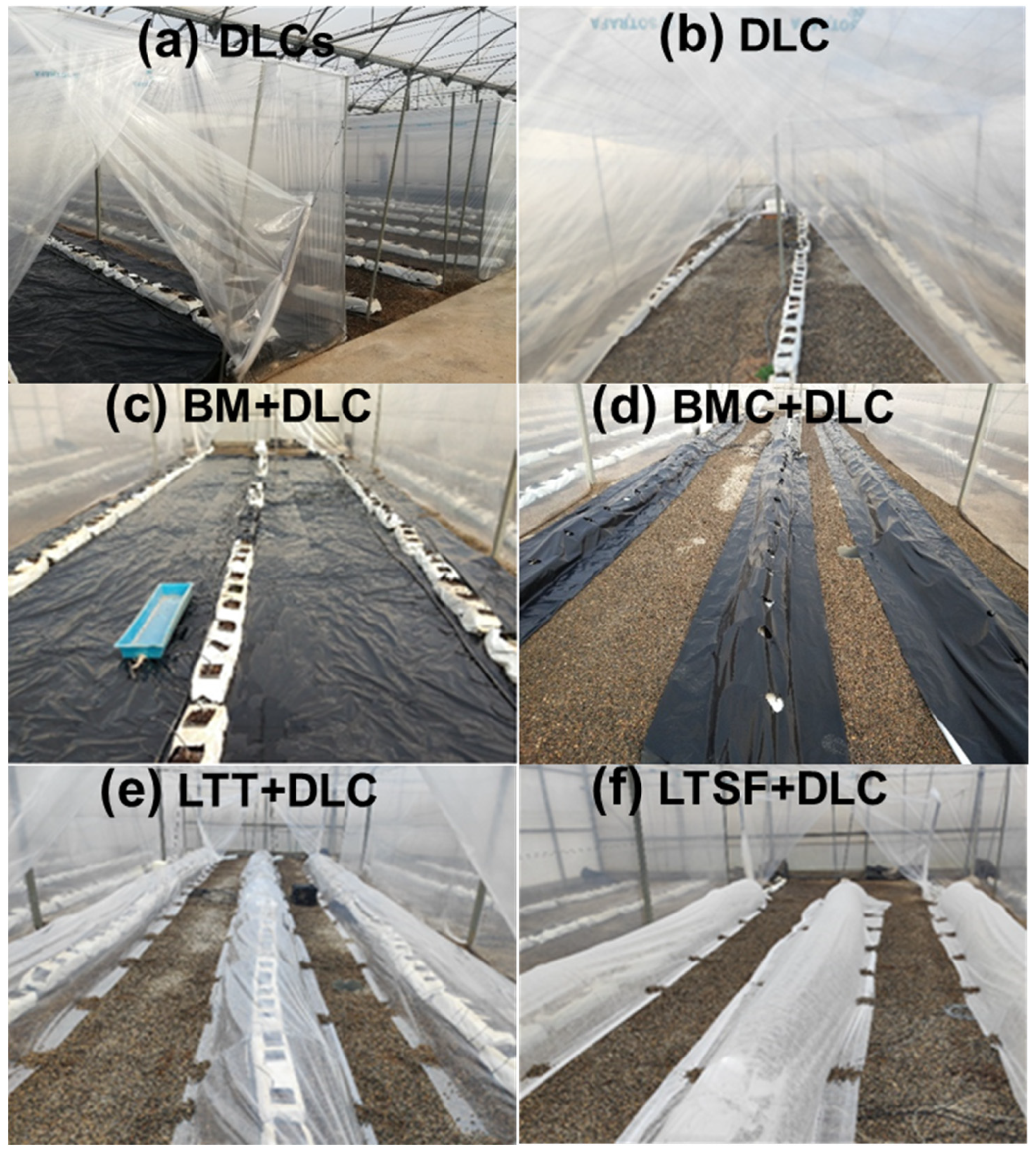
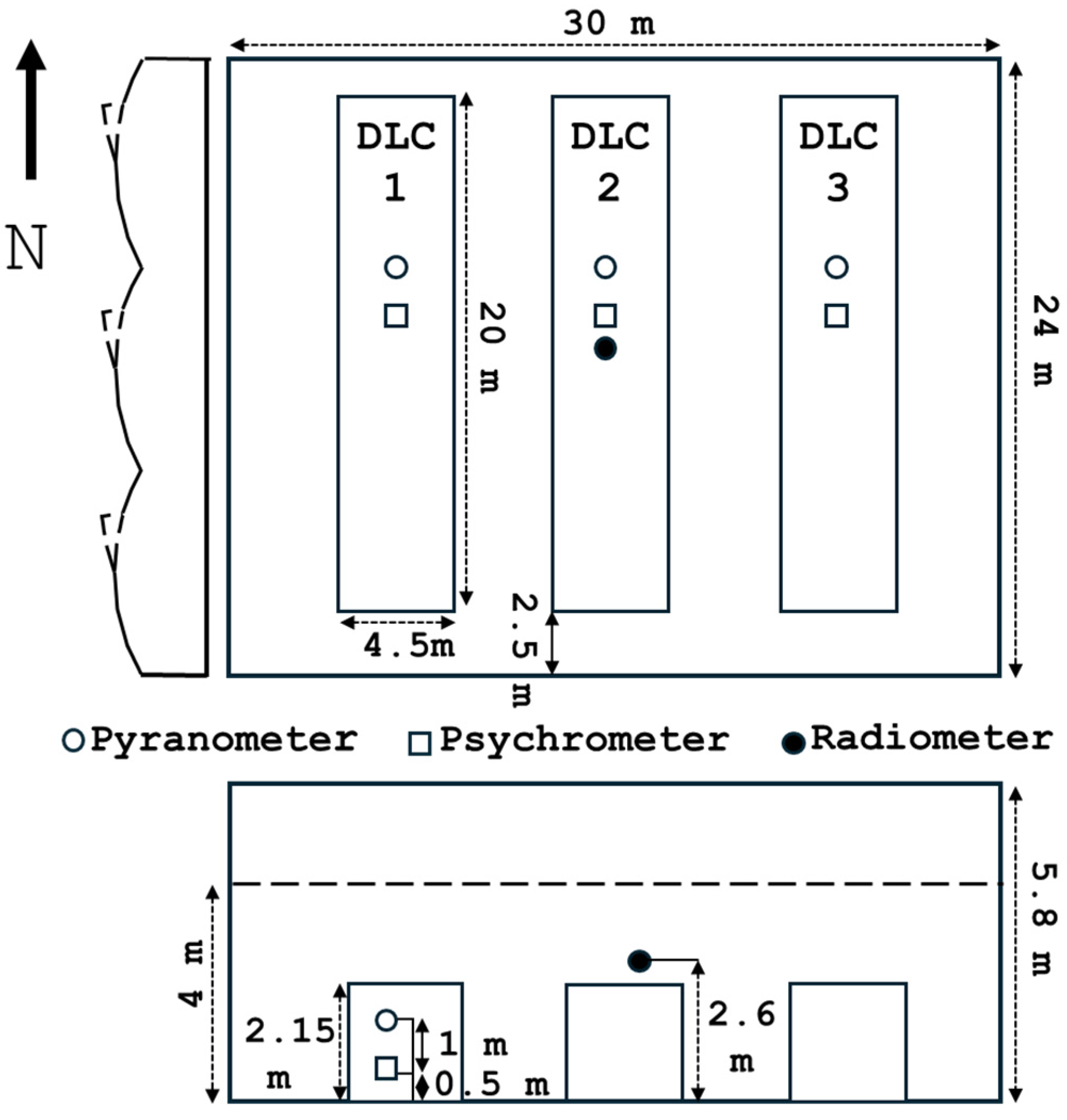
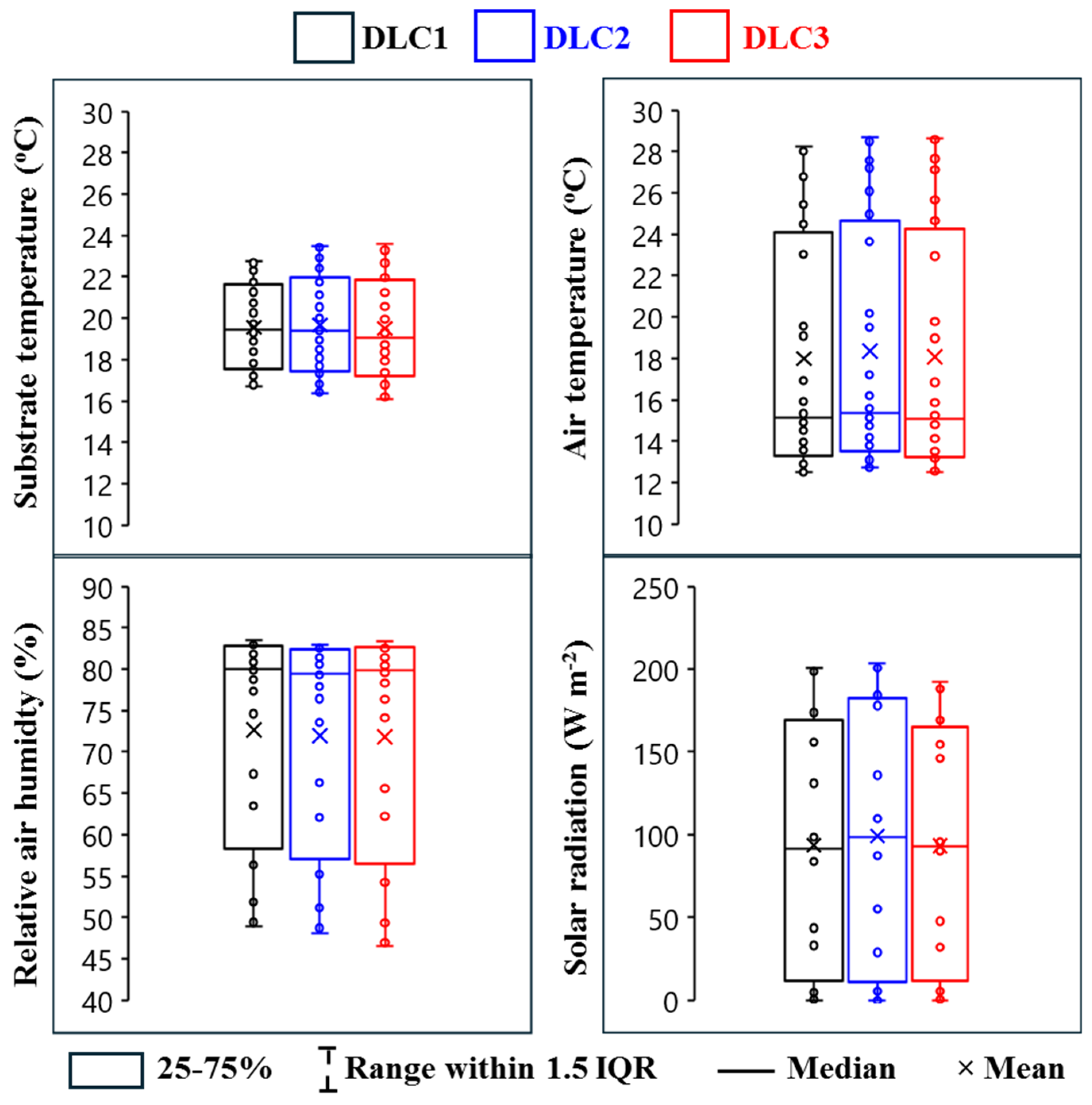

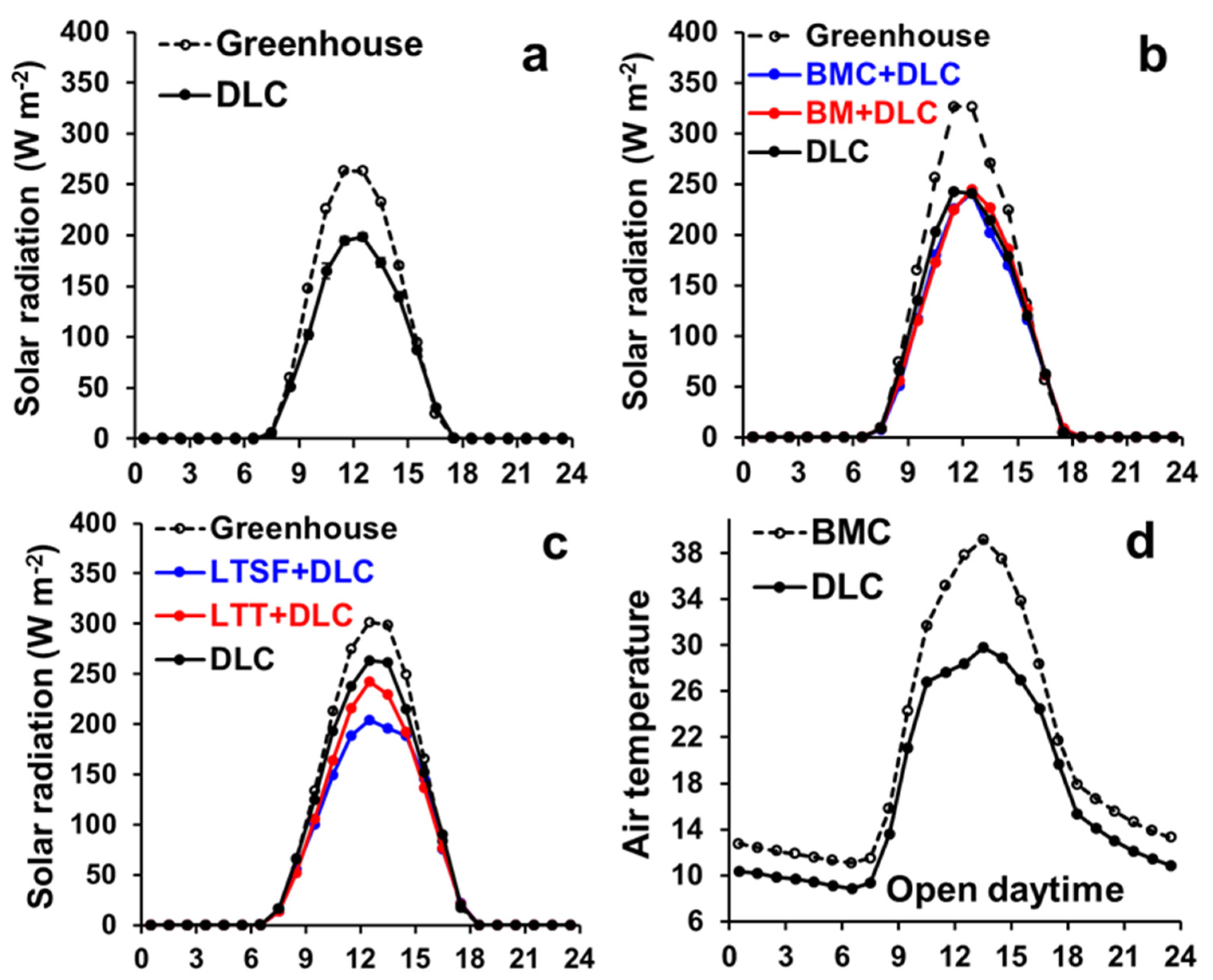
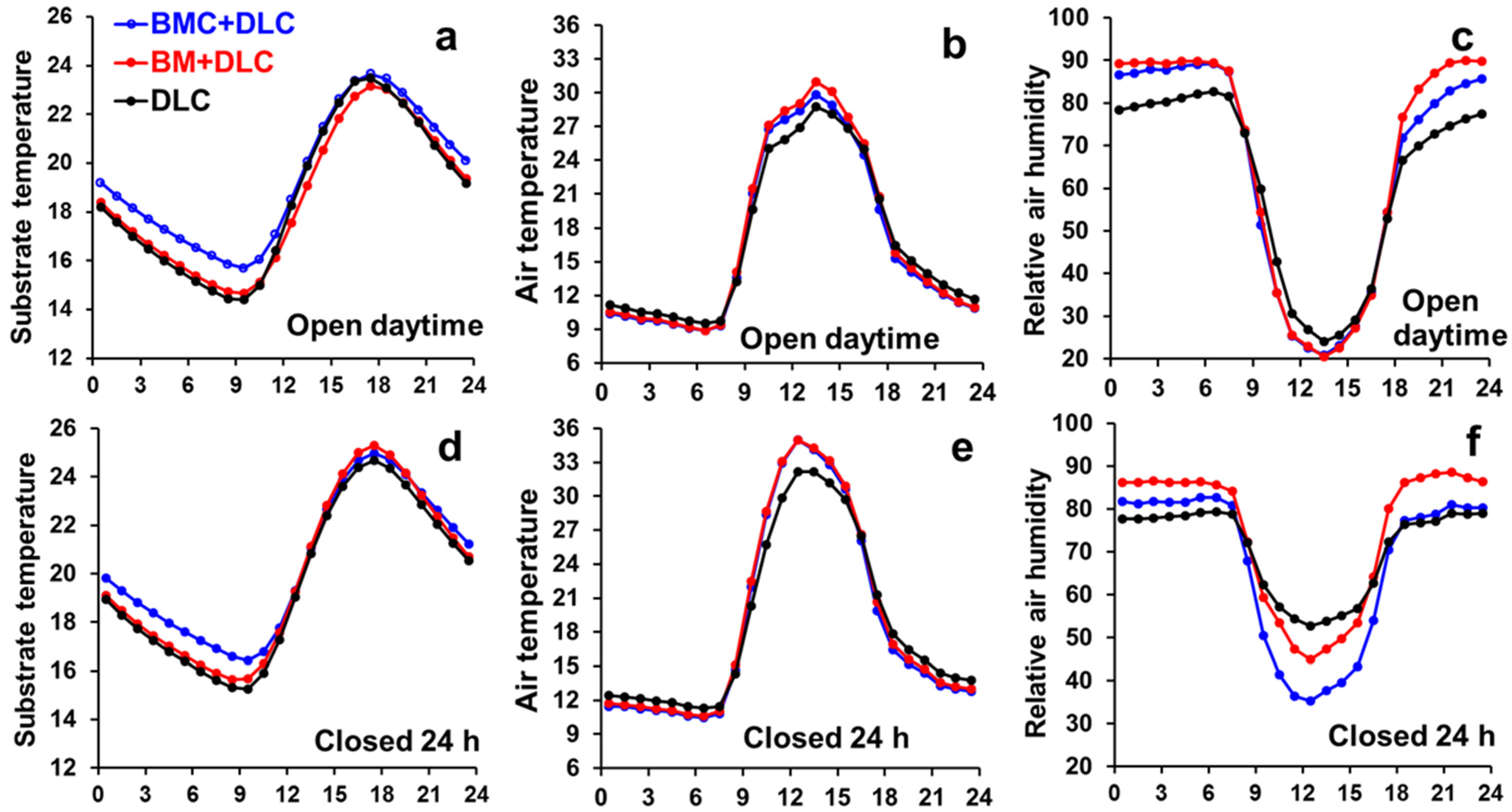

| Experiment 1 (DLCs) | Open 24 h | Open daytime | Closed 24 h | ||||||
| TS | Ta | RH | TS | Ta | RH | TS | Ta | RH | |
| DLC | 18.8 | 16.9 | 66.2 | 20.1 | 18.6 | 68.8 | 20.0 | 19.5 | 78.2 |
| Greenhouse | 18.3 | 15.6 | 69.5 | 19.0 | 16.4 | 70.0 | 18.5 | 15.9 | 72.0 |
| Outdoors | - | 14.1 | 55.0 | - | - | - | - | 13.6 | 64.0 |
| Experiment 2 (black mulches) | Open 24 h | Open daytime | Closed 24 h | ||||||
| TS | Ta | RH | TS | Ta | RH | TS | Ta | RH | |
| BMC + DLC | 18.1 | 14.6 | 54.7 | 19.4 | 16.7 | 64.8 | 20.3 | 18.7 | 66.9 |
| BM + DLC | 16.8 | 14.7 | 57.0 | 18.6 | 17.1 | 66.8 | 19.9 | 19.0 | 74.3 |
| DLC | 16.8 | 14.7 | 55.8 | 18.6 | 16.8 | 61.8 | 19.6 | 18.8 | 70.6 |
| Greenhouse | 16.2 | 13.1 | 57.0 | 16.9 | 14.1 | 62.3 | 17.5 | 15.1 | 53.3 |
| Outdoors | - | 9.5 | 40.0 | - | 10.7 | 52.8 | - | 10.1 | 43.7 |
| Experiment 3 (low tunnels) | Open 24 h | Open daytime | Closed 24 h | ||||||
| TS | Ta | RH | TS | Ta | RH | TS | Ta | RH | |
| LTSF + DLC | 20.6 | 20.6 | 52.2 | 21.6 | 21.1 | 67.7 | 22.1 | 21.0 | 69.7 |
| LTT + DLC | 20.4 | 20.6 | 57.9 | 21.3 | 21.1 | 66.4 | 21.3 | 20.6 | 69.6 |
| DLC | 20.0 | 19.8 | 49.1 | 21.0 | 20.4 | 61.4 | 20.9 | 20.1 | 67.5 |
| Greenhouse | 19.2 | 17.9 | 49.6 | 19.8 | 18.0 | 59.5 | 18.3 | 15.2 | 52.5 |
| Outdoors | - | 14.5 | 37.2 | - | 14.8 | 55.9 | - | 10.6 | 38.3 |
Disclaimer/Publisher’s Note: The statements, opinions and data contained in all publications are solely those of the individual author(s) and contributor(s) and not of MDPI and/or the editor(s). MDPI and/or the editor(s) disclaim responsibility for any injury to people or property resulting from any ideas, methods, instructions or products referred to in the content. |
© 2025 by the authors. Licensee MDPI, Basel, Switzerland. This article is an open access article distributed under the terms and conditions of the Creative Commons Attribution (CC BY) license (https://creativecommons.org/licenses/by/4.0/).
Share and Cite
Bonachela, S.; Sánchez-Guerrero, M.C.; López, J.C.; Medrano, E.; Hernández, J. Evaluation of New Passive Heating Systems for Low-Cost Greenhouses in a Mild-Winter Area. Horticulturae 2025, 11, 752. https://doi.org/10.3390/horticulturae11070752
Bonachela S, Sánchez-Guerrero MC, López JC, Medrano E, Hernández J. Evaluation of New Passive Heating Systems for Low-Cost Greenhouses in a Mild-Winter Area. Horticulturae. 2025; 11(7):752. https://doi.org/10.3390/horticulturae11070752
Chicago/Turabian StyleBonachela, Santiago, María Cruz Sánchez-Guerrero, Juan Carlos López, Evangelina Medrano, and Joaquín Hernández. 2025. "Evaluation of New Passive Heating Systems for Low-Cost Greenhouses in a Mild-Winter Area" Horticulturae 11, no. 7: 752. https://doi.org/10.3390/horticulturae11070752
APA StyleBonachela, S., Sánchez-Guerrero, M. C., López, J. C., Medrano, E., & Hernández, J. (2025). Evaluation of New Passive Heating Systems for Low-Cost Greenhouses in a Mild-Winter Area. Horticulturae, 11(7), 752. https://doi.org/10.3390/horticulturae11070752







